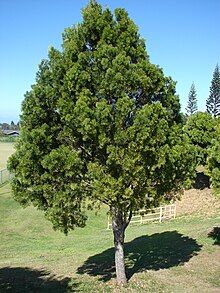Afrocarpus gracilior
| Afrocarpus gracilior | |
|---|---|

| |
| Scientific classification | |
| Kingdom: | Plantae |
| Clade: | Tracheophytes |
| Clade: | Gymnospermae |
| Division: | Pinophyta |
| Class: | Pinopsida |
| Order: | Araucariales |
| Family: | Podocarpaceae |
| Genus: | Afrocarpus |
| Species: | A. gracilior
|
| Binomial name | |
| Afrocarpus gracilior | |
Afrocarpus gracilior (syn. Podocarpus gracilior) is a species of coniferous tree in the family Podocarpaceae known as benet in Marakwet and East African yellowwood, African fern tree, or bastard yellowwood in English[1][2][3]
It is native to eastern Africa, in Ethiopia, Kenya, Tanzania, and Uganda, in Afromontane habitats.[1]
This is a common species found in many types of tropical mountain forest habitat. It is a dominant species in some areas. Nevertheless, it may be in slow decline due to deforestation and logging.[1]
Description
[edit]
Afrocarpus gracilior is a medium-sized tree, growing 20–40 m tall, rarely to 50 m, with a trunk diameter of 50–80 cm. The leaves are spirally arranged, lanceolate, 2–6 cm long and 3–5 mm broad on mature trees, larger, to 10 cm (4 in) long and 6 mm broad on vigorous young trees.
The seed cones are highly modified, with a single 2 cm (1 in) diameter seed with a thin fleshy coating borne on a short peduncle. The mature seed is purple, and is dispersed by birds and monkeys which eat the fleshy coating. The pollen cones are solitary or in clusters of two or three on a short stem.[4]
Taxonomy
[edit]Studies in 2000 and 2002 provided enough evidence to support splitting the genus Podocarpus into Podocarpus and Afrocarpus. Thus, P. falcatus and P. gracilior were renamed to A. falcatus and A. gracilior.[5] Later DNA, biogeographical, morphological, and anatomical evidence suggested the following relationships between the species of Afrocarpus:[6]
|
Nageia (outgroup) | |||||||||||||
| Afrocarpus |
| ||||||||||||
Uses
[edit]It is an important timber tree in its native range, where it is harvested for local use and export. It is used for construction of buildings and furniture. It is grown in plantations elsewhere in the world.
It is cultivated as an ornamental tree, and planted as a shade tree.[1]
Notes
[edit]- Dallimore, W., & Jackson, A. B. (1966). A Handbook of Coniferae and Ginkgoaceae, 4th ed., revised. Edward Arnold.
References
[edit]- ^ a b c d e Farjon, A. 2013. Afrocarpus gracilior. The IUCN Red List of Threatened Species. Version 2014.3. Downloaded on 11 April 2015.
- ^ Timberlake (1994). "Vernacular names and uses of plants in Northern Kenya". Journal of East African Natural History. 83: 31. doi:10.2982/0012-8317(1994)83[31:VNAUOP]2.0.CO;2.
- ^ "A study of the medicinal plants used by theMarakwet Community in Kenya".
{{cite journal}}: Cite journal requires|journal=(help) - ^ Afrocarpus gracilior. The Gymnosperm Database.
- ^ Abdillahi; Stafford; Finnie; Van Staden. "Ethnobotany, phytochemistry and pharmacology of Podocarpus sensu latissimo (s.l.)". South African Journal of Botany. 76.
- ^ Knopf; Schulze; Little; Stützel; Stevenson (2012). "Relationships within Podocarpaceae based on DNA sequence, anatomical, morphological, and biogeographical data". Cladistics. 28 (3): 271–299. doi:10.1111/j.1096-0031.2011.00381.x. PMID 34872191. S2CID 86581015.

